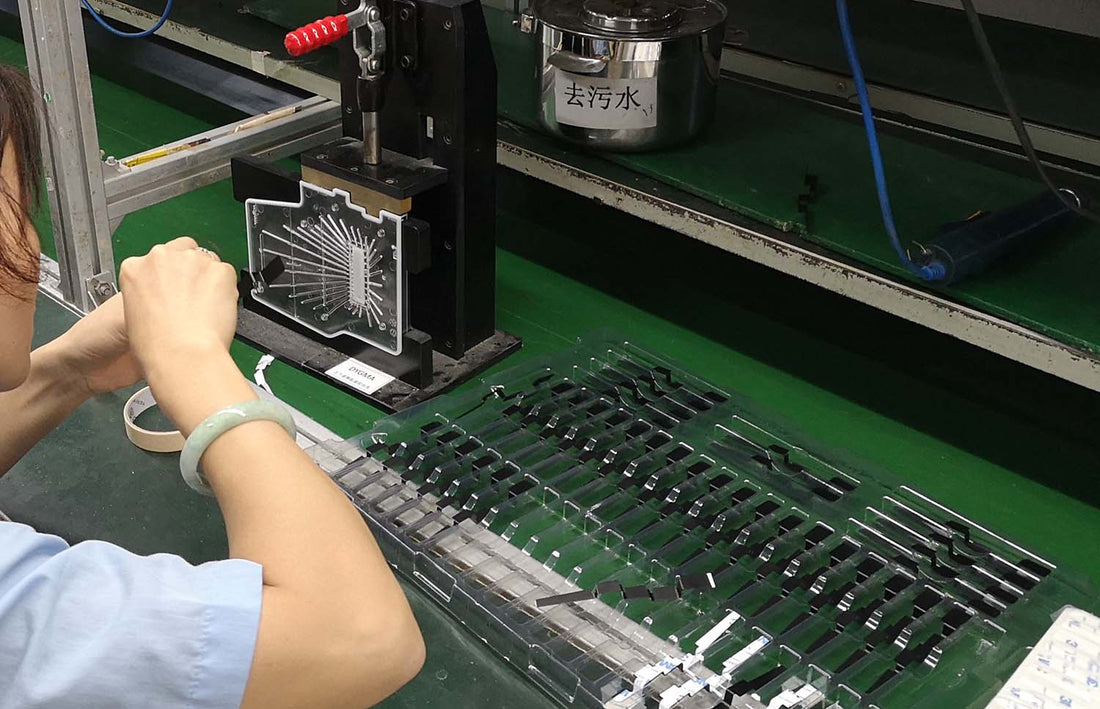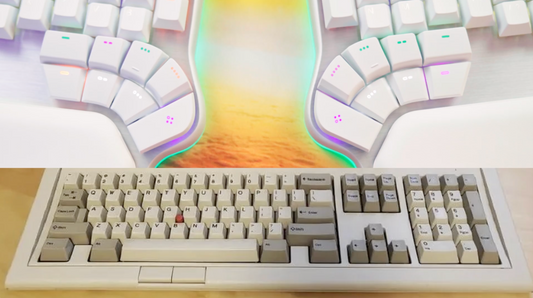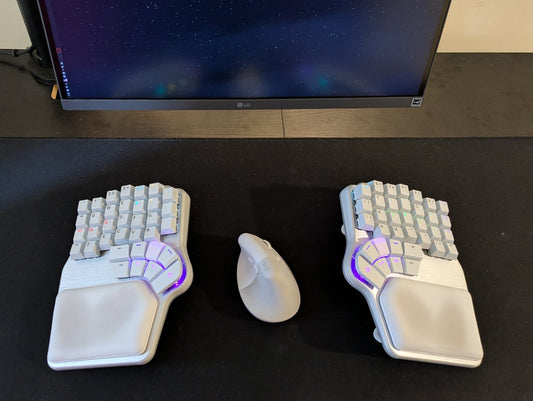Continuation of Tales from the Factories: Part 1
We’re back with our Tales from the Factories.
Manel finally arrived from China this week and he has more stories to tell us about his trip! If you didn’t read the previous update, we talked about the stories and experiences Manel faced during the mass production process in China.
It’s been a very busy past few weeks but we’re working hard to make sure we deliver your keyboards in the best condition as soon as possible.
Here are the Tales from the Factories.
TALE 6. The Joint Cover Aberration

When we mounted the 2 keyboards, we used the industrial glue to stick the joint cover to the base. It took more time than expected to glue the joint cover with the testing jig but eventually, it fit.


After checking the 2 keyboards, we asked the factory to mount 150 sets for the pre-production. It took so long that we had to delay pre-production one more day.
When 40 units were assembled, we realised that most of them had a defect in the joint cover. The joint covers were bent! We had to stop the assembly line to check the cause of the problem.
We asked the metal factory to send their engineers. They sent their workers and they tried to manually fit the joint cover. It wasn’t successful. The joint covers were too bent.

We found out that the reason was because of the sandblasted finishing done to the joint. Since the joint cover is thin, when they put the finishing, it would bend.
We had a few options but they all had some drawbacks.
- Option 1: Do not sandblast the joint cover, but paint them.
Con: The paint was too weak. It would scratch easily. - Option 2: Reduce the sandblasting level.
Con: It would take too much time to do and we can’t wait that long. But we could try for future orders. - Option 3. Keep it as it is, but with better glue and assembly control.
Con: It’s too risky because defects could appear after time or with temperature change. -
Option 4. Do not sandblast the joint cover but anodize it directly.
Cons: Finishing will look shinier and different from the top panel but it will still look good.
We finally made samples of Option 4 and approved it.
Now that the shape of the metal joint cover is better, we can use double-sided tape, which was much better for the assembly line and took less time.

So we decided to mount 10 sets of keyboards with double-sided tape. After 24 hours, they all still worked fine.
We then decided to assemble 500 keyboards. The next morning, ALL left joint covers were defective! They were no longer sticking to the base 😩
We had to cancel mass production 😭
We spent the next hours analyzing the problem. We found that the fit of the left joint cover to the left base wasn’t secure. It wobbled. It was hard to detect at first because it looked totally fine. There was about a 0.5mm gap, but it was big enough to unstick the double-sided tape.
So we called the metal engineer again. He confirmed that the pieces (the sizes of the joint covers) were slightly wrong. But it was enough to mess things up.
He swore that the fit was perfect before. We had a tense conversation trying to find the problem and who was at fault.
They then tell us that we can use another glue, a stronger one, instead of the original glue or double-sided tape. So we quickly mounted 10 more keyboards using the new glue for the joint cover. Now that the pieces were not sandblasted, it was easier to mount. We had to use small clips to keep everything together while the glue cured. It took another 24 hours for it to finish.
The result was rock solid 💪

At the same moment, the General Manager of the metal factory called us. He showed us through photos that the raw joint cover fit perfectly before anodizing.
He believed the reason the joint cover was loose was that when they put the piece into the dielectric bath, they clamped it too strongly.
In the metal factory, both left and right joint covers are made at the same time as a whole piece.

They then split the halves into becoming the left and right joint covers.
The pieces are then sent to another factory, the anodising factory, where they are sandblasted and dipped in the dielectric bath.
The GM suggested for our next batch, we should have the pieces sandblasted and put into the dielectric bath before splitting them. This way, we don't clamp the metal but let it hang. Once that's done, it would be sent back to the metal factory where it will be split.
LEARNINGS:
- It’s best to push for perfection from the start especially before mass production. I had accepted this piece despite its imperfections for a long time, with the promise from the factories that they would make it better for mass production.
TALE 7. The Transport Case Desperation

The travel case was scheduled to be delivered on the 19th of October.
We received the agreed 200 cases for the pre-production units. We checked them and found there were minor things that needed improvement, like how the elastic strip for test switches was too tight.
We also realised that the weight of the travel case was lighter than the previous sample. The previous sample weighed 550g and the current one weighed 450g!
I got worried and thought the supplier cut corners and gave us a poor quality product. So I started analysing the parts one by one. Everything was fine. The only part that was different was the lid. The material was different but it was sturdy enough so I decided to accept the modification. After all, having a lighter travel case is better.
We then had to wait for the rest of the order.
We should’ve received it on the 21st of October but the travel case factory called us the day before, telling us that everything is prepared except for the foam for the lid.
The foam came from a different supplier and we didn’t know them. They said that the foam supplier had a problem with their machine so they couldn’t ship as scheduled. They even sent us a photo of the broken machine as proof.
On the 22nd of October, we were told that the foam supplier was repairing their machine. The travel case factory even sent us photos of the cases already ready and just missing the foam. They said they would send the travel case the following week.
We finally received the travel cases 10 days later the scheduled date. Most of them had quality issues in the foam. They didn’t place the foam properly. It was too loose.

The travel case factory had to send their workers over to the assembly factory to work on the travel cases again. It was a long process but they got the job done.

LEARNINGS:
- Modifications, no matter how small, will cause a delay. When we launched manufacturing, we still continued to ask for small modifications and adjustments. The factory didn't really start manufacturing until the product was 100% approved. But we thought they had already started manufacturing. As a result, they delayed the order.
- When you accept the design of a product, it shouldn’t be modified until after the next batch. Even if only one component isn’t ready, don’t start manufacturing.
- Despite the delay, communication with this particular supplier was good. Our contact person from this company is a sincere and straightforward person, which made the problem easy to fix.
TALE 8. The Functional Test Paranoia

The mass production assembly was scheduled on October 22 at 2pm. We were prepared to assemble 500 units. The bases were ready and all PCBs were tested and prepared.
At 10:00 am that day, I had spare time and decided to do a user test with some of the pre-production units. I selected 4 keyboards and tested them with my laptop, typing with them for about 30 minutes.
They all failed.
The keyboards kept disconnecting. After 2-3 minutes of typing, they would fail. I PANICKED! 😖
I called our consultant in the assembly factory and showed him.
We tried different things to fix the problem. But unexpected things started to happen: one side would stop working, the LEDs would flash when the color layer was changed, the Neuron would disconnect and reconnect.
We tried changing the cables and changing the Neuron. The results were varied. Some keyboards worked for 10 minutes, some failed, some worked 100%.
I asked Frank to take his computer and do the same tests I was doing. He did, and nothing failed. His laptop didn’t have the same OS as mine.

I thought it could be related to that. We then tested the keyboards with a Mac computer and they didn’t fail.
Then I remembered I have been having problems with my computer in the last few weeks. The batteries would die after 10 minutes without power. And I would hear strange noises inside it when carried as if something was loose inside.
I unplugged the charger from the laptop and then, all the keyboards worked fine! FML 😭
Then we started doing the mass production assembly. After assembling 150 units, I decided to take 10 units and do an intense test.
I discovered something very strange. On the left side, some of the LEDs were emitting the wrong colors.
I didn’t understand why. It only happened when I connected the Neuron first then connected the sides of the keyboard.

I called Matt early in the morning and prepared some videos and photos for him to see the problem I was going crazy about.
He called 15 minutes later and told me what the problem was. The ANSI-ISO detection wasn’t working properly. It was a firmware bug.
He changed the code. We flashed the Raise. The problem disappeared. We then flashed all the Neurons again before packing. Now all the units are working fine.
LEARNINGS:
- Find the right person to manage and take care of that person. Like any human relationship, you need respect and trust. If you don’t respect or trust them, then it’s best to look for another person for your team.
- Communication is the key. Never leave the room if you don't understand what is going on.
- The key thing is to know what is next and what to do if things fail.
There are still more stories to be told from the mass production of the Raise.
All in all, it’s been a great learning experience for all of us. We’re certain that in the next batch and in the next product, we will be able to face the difficulties with better know-how. But more importantly, we would know what to not and what not to do to prevent these issues from happening again.
Currently, we are still packing the remaining keyboards.
We will start shipment once we have all the units ready. As soon as they’re done, you will be the first ones to know!
We’re very close to the end and we’re all very excited to see this through!
Thanks for reading the update. Till next week!
- Dygma Team









